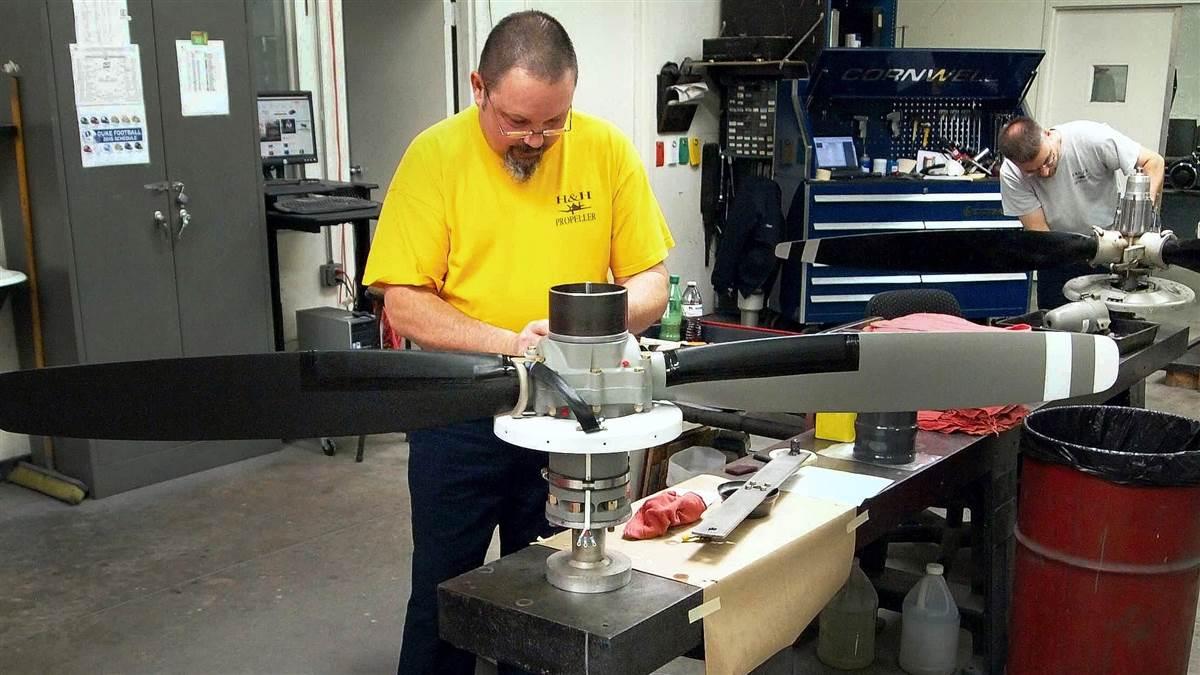Opinion: Propwash
How often does your propeller really need to get overhauled?

If your airplane has a constant-speed prop, overhauling it is going to set you back about $3,000 including removal and installation labor. If it has deice boots, figure another $1,000. If you fly a twin like mine with two full-feathering constant-speed deiced props, well…ouch!
Nowadays most props have a TBO of 2,000 or 2,400 hours and 60 or 72 months, whichever comes first. Doing the math, you’d have to average more than 400 hours per year for the 2,000 or 2,400 hours to come first. For most of us, it’s the calendar time component of the TBO that always comes up first. The average owner-flown GA airplane flies less than 100 hours a year, which means that the prop may come “due” for overhaul in less than 500 hours.
Do we really have to overhaul our props every five or six years regardless of how few hours are on them? Does it even make sense to do that?
What the regs say
 If you’re a Part 91 (noncommercial) operator, you’re generally not required by regulation to pay the slightest attention to TBOs, regardless of whether they are engine TBOs, propeller TBOs, or TBOs on appliances like prop governors, pumps, alternators, or any other component. As far as the FAA is concerned, any manufacturer-specified maintenance interval—time between overhauls, time between replacements, inspection intervals, and more—is nothing more than a suggestion that you are free to honor or disregard at your discretion. The FAA’s longstanding and clearly articulated legal position is that no manufacturer has the right to dictate when or how frequently maintenance must be performed. Only the FAA has that right.
If you’re a Part 91 (noncommercial) operator, you’re generally not required by regulation to pay the slightest attention to TBOs, regardless of whether they are engine TBOs, propeller TBOs, or TBOs on appliances like prop governors, pumps, alternators, or any other component. As far as the FAA is concerned, any manufacturer-specified maintenance interval—time between overhauls, time between replacements, inspection intervals, and more—is nothing more than a suggestion that you are free to honor or disregard at your discretion. The FAA’s longstanding and clearly articulated legal position is that no manufacturer has the right to dictate when or how frequently maintenance must be performed. Only the FAA has that right.
The FAA dictates certain inspection and maintenance intervals through Part 91 regulations. Notably, FAR 91.409(a) says that we’re required to perform annual inspections every 12 calendar months; 91.409(b) says that we’re also required to perform 100-hour inspections if we use our aircraft to carry passengers or give flight instruction for hire; 91.207(d) requires annual emergency locator transmitter inspections; and 91.411 and 413 require biennial certifications of transponders, altimeters, and altitude encoders. Between these FAA-mandated inspections, FAR 91.405 requires us to have discrepancies repaired, maintenance work logged and signed off, and inoperative equipment placarded. FAR 91.403 makes us responsible for complying with all applicable airworthiness directives and airworthiness limitations.
With respect to propellers, there are a tiny handful of ADs and airworthiness limitations that dictate TBOs or component life limits for a few very old propellers and a few oddball airframe/engine/propeller combinations (mostly involving turboprops). For the vast majority of us, however, the FAA leaves the when-to-overhaul decision totally up to the Part 91 owner/operator.
Why prop TBO is what it is
How can an aircraft owner make an informed decision about when to overhaul? I think a useful place to start is to look at how aircraft propeller manufacturers like Hartzell, McCauley, MT, and Sensenich come up with their TBO recommendations in the first place.
Why, for example, do the manufacturers define TBO in terms of both operating hours and calendar months? It’s because they’re concerned not only about wear and metal fatigue (which correlates directly with operating hours) but also about corrosion and seal deterioration (which correlates directly with calendar time and inactivity). The theory is that by defining TBO in terms of both hours and months, high-activity props will get overhauled before they wear out and low-activity props will get overhauled before they corrode excessively.
Now, that’s a nice theory but it misses some important factors that should influence how often prop overhauls are done. Ask any prop shop what the most serious problem they see when they disassemble propellers for overhaul, and they’ll all give you the same answer: corrosion. But, when it comes to corrosion, calendar time is less important than environmental and operational factors. A prop that lives in Tucson, Arizona, can remain corrosion-free much longer than one that lives in Tampa, Florida, and one that lives in a hangar will go a lot longer than one that lives on a tiedown. Also, a prop that flies 10 hours a month throughout the year will remain corrosion-free much longer than one that flies 20 hours a month in the summer and sits unflown in the winter (or vice versa).
None of these factors are considered in the one-size-fits-all TBOs that the manufacturers specify. In fact, manufacturers base their TBOs on worst-case assumptions to ensure they are appropriate for even the worst-case airplane in the fleet—you know, the one that sits out on a tiedown in Tampa just spitball distance from the Gulf of Mexico and only flies six months out of the year. This makes those TBOs inappropriately short for most of the fleet, especially the ones that are hangared in Tucson and fly regularly year-round.
A common-sense approach
 That’s why I recommend you adjust manufacturer-specified TBOs—particularly the calendar-time component—to fit your individual situation. If your airplane is tied down in an area of high corrosion risk—near the coast or the Gulf—perhaps you should comply with the 60- or 72-month schedule recommended by the prop manufacturer. If you’re based in an area of only moderate corrosion risk, you might reasonably go twice as long. If you’re lucky enough to be based somewhere like Tucson or Denver or Missoula where corrosion is banned by local statute, you could go triple. Give yourself extra credit if your airplane is almost always hangared, and ding yourself if your operation is seasonal or irregular.
That’s why I recommend you adjust manufacturer-specified TBOs—particularly the calendar-time component—to fit your individual situation. If your airplane is tied down in an area of high corrosion risk—near the coast or the Gulf—perhaps you should comply with the 60- or 72-month schedule recommended by the prop manufacturer. If you’re based in an area of only moderate corrosion risk, you might reasonably go twice as long. If you’re lucky enough to be based somewhere like Tucson or Denver or Missoula where corrosion is banned by local statute, you could go triple. Give yourself extra credit if your airplane is almost always hangared, and ding yourself if your operation is seasonal or irregular.
Lest you conclude this advice is dangerous heresy, I will tell you that some years ago I had the opportunity to have a one-on-one conversation with the head of product support for one of the major propeller manufacturers. I told him my thoughts about individualizing prop TBO along the lines I just described. “I can’t find fault with your thoughtful approach,” he confided, “but if you tell anyone I said that, I’d probably get in seriously hot water with our legal department.”
Interestingly, there’s one prop manufacturer—Sensenich—that has dropped all calendar-time recommendations on its propellers and quotes TBOs strictly in terms of operating hours. In fairness, however, I should point out that Sensenich makes only fixed-pitch props and that corrosion is much more of a concern with constant-speed props because it may be hidden inside the propeller hub. I’m not holding my breath for Hartzell, McCauley, or MT to follow Sensenich’s lead on this.
The half-price overhaul
The FAA allows A&P mechanics to work on virtually every component of an aircraft with two specific exceptions: propellers and instruments. Propeller repairs (anything beyond dressing small nicks and painting blade tips) must be done by an FAA-certified propeller repair station, and instrument repairs (anything beyond removal and installation) must be done by an FAA-certified instrument repair station. Consequently, most A&Ps know very little about propellers and instruments.
Soon after I became an A&P, I made a point of trying to fill this knowledge vacuum by visiting instrument shops and prop shops every chance I got. In March 1996, I had both of my Cessna 310’s propellers overhauled by American Propeller Service in Redding, California, and I got permission to spend the week hanging out at the prop shop while my props and dozens of others were being worked on. That was quite a learning experience.
One thing I noticed was that while most of the propellers were coming into the shop for overhauls, some were coming in for something called a “reseal repair” (sometimes called a “clean and seal”). I asked shop foreman Todd Marinkovich what the difference was between an overhaul and a reseal repair, and he explained that a reseal repair was basically an overhaul of the prop hub only, with the blades left alone. In contrast, a full overhaul involves stripping the blades of paint and deicing boots, putting them through fluorescent dye inspection, measuring the chord and twist at numerous stations along the length of the blade, performing any necessary trimming or twisting, and finally repainting the blades and installing new deicers if applicable. That’s a lot of labor, which is why a reseal repair typically costs half or less what an overhaul will cost.
That got me thinking. Unless my aircraft has sustained a prop strike, I really don’t need a prop shop to tell me whether my prop blades are airworthy. Blades are easy enough to inspect for nicks, corrosion pitting, and blade tracking without removing the prop from the airplane. However, the same can’t be said for the prop hub, which is basically a black box containing blade bearings and a complex pitch-change mechanism that can’t be inspected without removing the propeller and separating the blades from the hub—something only a prop shop can do.
So, I asked Marinkovich what he thought of the idea of simply sending the prop in periodically for a reseal repair and foregoing the complete overhaul unless inspection revealed something obviously wrong with the blades. His answer: “Sure, that’s what I’d do.” That was 25 years ago, and I’ve not had the props on my Cessna 310 overhauled since.
However, I must warn you about something: I’ve encountered a number of prop shops that refuse to do a reseal repair on a prop that’s past TBO, and insist on doing a full overhaul. So, before you have your prop pulled and sent in for a reseal repair, it’s a good idea to call the prop shop you’re planning to use and make sure they’re willing to do it.

